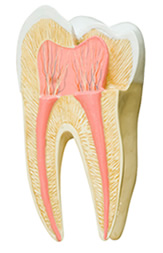General Dentistry
Periodontics
 Periodontal or gum disease is an infection of the tissues that surround and support your teeth. It is a leading cause of tooth loss in American adults. It has also been linked to heart disease, stroke, diabetes and other health problems.
Periodontal or gum disease is an infection of the tissues that surround and support your teeth. It is a leading cause of tooth loss in American adults. It has also been linked to heart disease, stroke, diabetes and other health problems.
Plaque is the sticky film of bacteria that is brushed and flossed away with proper oral care. When left on the teeth, plaque produces toxins that attack below the gum line in the sulcus, a shallow v-shaped crevice between the tooth and gums. This causes the bond between teeth and gums to break down. In the early stage of gum disease (gingivitis), gums may become red and swollen and bleed easily. In the more advanced stage (periodontal disease), teeth can loosen and fall out.
Good oral hygiene and regular dental examinations are essential in the prevention and early detection of gum disease – especially since you can have it without experiencing any warning signs.
Signs that you may have gum disease include:
- Gums that are red, swollen, tender, bleed easily or pull away from the teeth
- Persistent bad breath or bad taste
- Loose or separating teeth
- A change in the way your teeth fit together
- A change in the fit of partial dentures
Endodontics
 Endodontics is a dental specialty that involves treatment of the inside of the tooth, known as the dental pulp, which contains blood vessels, nerves and connective tissue to help form the outside of the tooth. These procedures are often needed when the pulp of the tooth becomes infected or inflamed, usually as a result of decay, repeated dental procedures or a crack or chip in the tooth that can lead to infection. Patients with these conditions may experience pain, sensitivity, tenderness and discoloration, as well as the development of an abscess.
Endodontics is a dental specialty that involves treatment of the inside of the tooth, known as the dental pulp, which contains blood vessels, nerves and connective tissue to help form the outside of the tooth. These procedures are often needed when the pulp of the tooth becomes infected or inflamed, usually as a result of decay, repeated dental procedures or a crack or chip in the tooth that can lead to infection. Patients with these conditions may experience pain, sensitivity, tenderness and discoloration, as well as the development of an abscess.
Your dentist can detect problems within the dental pulp through X-ray imaging, although some patients may need to undergo a root canal procedure, for diagnostic purposes, in order to detect holes or cracks in the tooth that may be the cause of pulp damage.
Endodontic Procedures
 The most common endodontic procedure is root canal therapy, which can diagnose and treat damage in the dental pulp. A hole is drilled into the tooth and thoroughly cleansed from the inside. The hole is carefully sealed so no dirt or bacteria can reenter the tooth. A crown or a filling is needed after the procedure to restore the appearance of the tooth and prevent further damage.
The most common endodontic procedure is root canal therapy, which can diagnose and treat damage in the dental pulp. A hole is drilled into the tooth and thoroughly cleansed from the inside. The hole is carefully sealed so no dirt or bacteria can reenter the tooth. A crown or a filling is needed after the procedure to restore the appearance of the tooth and prevent further damage.
Also known as root end resection, apicoectomy involves the removal of infected tissue and the end of the root. This procedure is most commonly performed after an unsuccessful root canal procedure. A filling is needed after the procedure to restore the appearance of the tooth and prevent further damage.
There are other types of endodontic procedures performed to treat more severe cases of pulp damage that may not respond or may recur after initial treatment. Your dentist will decide which procedure is right for you after a thorough evaluation of your condition.
Each patient is given individualized attention to ensure that they receive the highest quality of care.
For more information about General Dentistry or to schedule an appointment, feel free to fill out our convenient contact form or call us directly at 212-935-9300.

